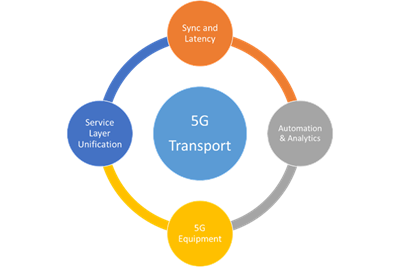5G xHaul transport can be complex: how to make it simple and future-proof
This blog was first published by ACG Research.
Let’s face it. 5G xHaul transport can be complex. In addition to the traditional backhaul, there is fronthaul and new midhaul that also have complex planning requirements: latency, timing, and synchronization have stricter limits for 5G compared to 3G/4G, the new requirement of network slicing, and a variety of new interfaces to support. A poorly planned 5G transport network can result in an unoptimized network that is capex intensive and an operational nightmare that is incapable of delivering the service performance and quality of experience required by end-users, both humans and machines (IoT).
Is there a way to make it simple and future-proof? This blog answers this question by listing guidelines that point network planners in the right direction toward simplifying and future-proofing the xHaul transport network.

Guideline 1: Unify the Service Layer
In terms of the number of service layers in the 5G network, fewer are better. Instead of putting services on multiple layers, such as IP, Ethernet, OTN, and/or DWDM, choose one of them, strategically. This is specifically true when network slicing is used. Why? Network slicing is already complex. Having one technology end to end for network slicing makes the network simpler, easier to provision and maintain.
Nothing beats IP in providing such a seamless service layer (providing both L2 and L3 services) from the cell site to the core site, which also has solid aggregation capabilities. When the service layer is stitched from different technologies, provisioning and managing them end to end is always difficult.
IP/MPLS is challenging to manage and moreover, is bloated with heavy signaling protocols such as RSVP and LDP, which make the network complex. Thanks to Segment Routing, which uses source-based routing, IP/MPLS has become simpler and easier to manage without the need for these protocols. Additionally, EVPN simplifies the creation of the VPN layer. Together, Segment Routing and EVPN can considerably simplify the xHaul network; it is a—one that is recommended—simpler approach for creating a slice.
Guideline 2: Design for Timing, Synchronization, and Latency
In general, the lesser the latency in the transport, the better it is. Two latencies should be considered:
- An end-to-end latency that depends on the type of services offered by an operator, mobile or wholesaler. For example, ultra-reliable low-latency communication (urLLC) requires much stricter latency requirements, in the range of few milliseconds, compared to enhanced mobile broadband (eMBB). To meet such latency, operators should think about establishing edge data centers closer to the users’ equipment and implement time-sensitive networking (TSN).
- The second latency relates to that for fronthaul in C-RAN. This latency is in the range of 100 microseconds or less. This dictates how far the Distributed Unit (DU) should be located from the radio site.
In addition to latency, timing and synchronization are key requirements to 5G transport. Although packet-based technologies are not the best for latency and jitter, which can affect synchronization, initiatives such as Time Sensitive Network (TSN) by IEEE (related to Ethernet) and DetNet initiative by IETF (related to IP) make these packet technologies more deterministic in terms of jitter, wander, and time deviation, thus suitable to carry timing and synchronization packets.
One emerging standard by OIF called FlexEthernet can provide TDM like resource division and predictable service guarantee on Ethernet layer. For ultra-low latency services, FlexEthernet is one of the available options for service providers.
The transport equipment should support the boundary clock functionality using ITU-T G.8275.1 profile and high accuracy of minimum Class C for fronthaul applications.
The strict timing and synchronization requirements in xHaul transport demand careful placement of T-GM (Telecom Grandmaster) in the network. C-RAN needs many distributed clocks at centralized locations to time synchronization radio sites. If the transport equipment can support T-GM and Global Navigation Satellite System receiver functionality, it will greatly reduce the need for external T-GM clocks, thus providing significant flexibility and capex savings.
When designing for 5G xHaul transport, it is imperative to know the latency required for services to decide the placement of data centers, Centralized Units (CUs), and DUs. More importantly, when using packet-based fronthaul, be aware of the options available to mitigate latency as well as jitter.
Guideline 3: Automation, Orchestration, and Analytics Are Key Elements for 5G
As a network slice traverses multiple wireless and wireline domains, such as radio, transport, and core, 5G needs intelligent data-driven automation and orchestration to manage services across these different layers. In this context, there are multiple factors to consider for transport:
- Manual provisioning using Command Line Interface commands is time-consuming and highly error-prone, resulting in obstacles to future-proof automation. Instead, model-based automation using NETCONF together with open YANG models is future-proof, easier to implement, and straightforward to integrate with the SDN controller and orchestration system. Centralized intelligence using the SDN controller is preferred as it helps in traffic engineering the LSPs from a central location.
- Nothing is worse than having a slice but no visibility into the end-to-end slice. The orchestration tool should provide rich performance visibility across multiple layers: IGP, BGP, gNMI (gRPC), SNMP, Syslog, NetFlow, etc. Then using machine learning with closed-loop automation, it can take proactive corrective actions in the network, guaranteeing the quality of service of the slice.
Guideline 4: Choose Your Transport Equipment Wisely
There are a few things to consider when choosing transport equipment:
- On the xHaul transport side, routers should support not only the required IP capabilities, but also additional features needed to support a graceful 4G to 5G evolution, such as TSN, eCPRI, CPRI with RoE, L1 Offload, and F1 interfaces.
- High density of 10/25GbE to provide the infrastructure required for network densification.
- 100/200/400 GbE NNI interfaces to deliver the bandwidth scalability 5G will require.
- On the timing and synchronization side, it should support, telecom grand master, boundary clock functionality and GNSS receiver using G.8275.1 profile with the accuracy of at least Class C.
- On the slicing side, the equipment should have the flexibility to support both soft slicing, for example, using Segment Routing and hard slicing, such as FlexEthernet.
- On the automation side, the routers/management system should support automation using NETCONF/YANG and powerful data-driven analytics across multiple layers, including IGP, BGP, SNMP, NetFlow, gNMI (gRPC) and Syslog, which provide end-to-end visibility from the optical layer to the packet switching and routing layers with intelligent closed-loop automation.
As you may have concluded, 5G xHaul transport needs a solution-level approach that includes both a feature-rich box and a well-integrated automation and orchestration platform. Ciena provides a complete yet open solution with its innovative Adaptive IPTM portfolio, which is well integrated with its Blue Planet Automation software. The company has simplified the 5G xHaul transport with a lean and open set of IP protocols driven by analytics focused, multidomain and multivendor closed-loop orchestration layer.








